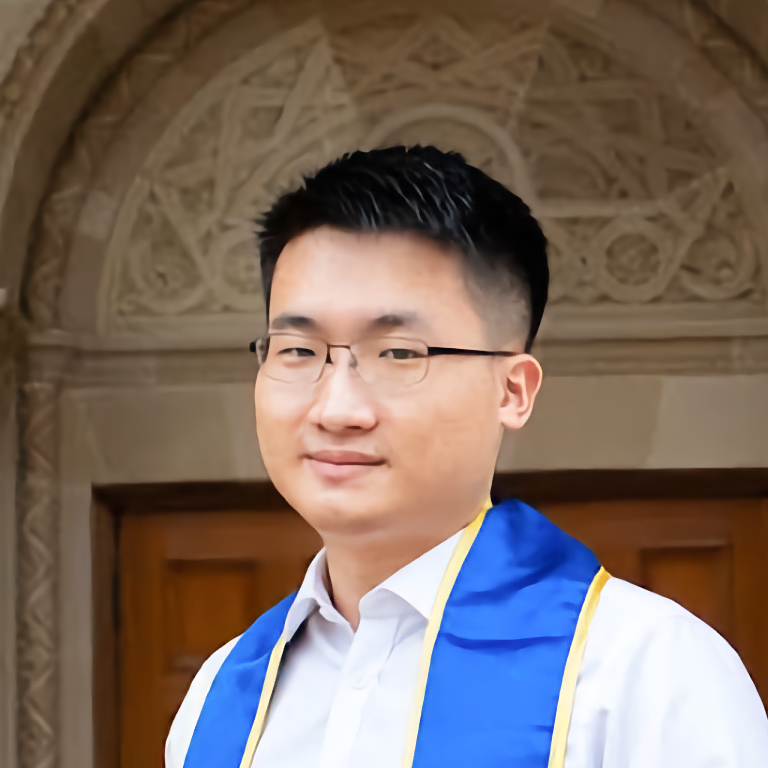
|
I am a final-year PhD researcher in computer science at Stanford AI Lab, advised by Chelsea Finn. I was a researcher at Google DeepMind, working with Jie Tan. My research is supported by Pierre and Christine Lamond Fellowship. Previously, I was a master's student in the Machine Learning Department and a student researcher in the Robotics Institute at CMU, advised by Deepak Pathak and Jitendra Malik. I completed my bachelor's in Computer Science and Applied Math at UCLA, advised by Song-Chun Zhu. My research interests lie in the intersection of Robotics, Machine Learning and Computer Vision. I care about robust robot performance and deployable robot systems in the unstructured open world. |
|
webpage |
pdf |
abstract |
bibtex |
arXiv |
code |
video
One of the key arguments for building robots that have similar form factors to human beings is that we can leverage the massive human data for training. Yet, doing so has remained challenging in practice due to the complexities in humanoid perception and control, lingering physical gaps between humanoids and humans in morphologies and actuation, and lack of a data pipeline for humanoids to learn autonomous skills from egocentric vision. In this paper, we introduce a full-stack system for humanoids to learn motion and autonomous skills from human data. We first train a low-level policy in simulation via reinforcement learning using existing 40-hour human motion datasets. This policy transfers to the real world and allows humanoid robots to follow human body and hand motion in real time using only a RGB camera, i.e. shadowing. Through shadowing, human operators can teleoperate humanoids to collect whole-body data for learning different tasks in the real world. Using the data collected, we then perform supervised behavior cloning to train skill policies using egocentric vision, allowing humanoids to complete different tasks autonomously by imitating human skills. We demonstrate the system on our customized 33-DoF 180cm humanoid, autonomously completing tasks such as wearing a shoe to stand up and walk, unloading objects from warehouse racks, folding a sweatshirt, rearranging objects, typing, and greeting another robot with 60-100% success rates using up to 40 demonstrations.
@inproceedings{fu2024humanplus,
author = {Fu, Zipeng and Zhao, Qingqing
and Wu, Qi and Wetzstein, Gordon
and Finn, Chelsea},
title = {HumanPlus: Humanoid Shadowing
and Imitation from Humans},
booktitle = {Conference on Robot Learning ({CoRL})},
year = {2024}
}
|
|
|
webpage |
pdf |
abstract |
bibtex |
arXiv |
code |
video
Imitation learning from human demonstrations has shown impressive performance in robotics. However, most results focus on table-top manipulation, lacking the mobility and dexterity necessary for generally useful tasks. In this work, we develop a system for imitating mobile manipulation tasks that are bimanual and require whole-body control. We first present Mobile ALOHA, a low-cost and whole-body teleoperation system for data collection. It augments the ALOHA system with a mobile base, and a whole-body teleoperation interface. Using data collected with Mobile ALOHA, we then perform supervised behavior cloning and find that co-training with existing static ALOHA datasets boosts performance on mobile manipulation tasks. With 50 demonstrations for each task, co-training can increase success rates by up to 90%, allowing Mobile ALOHA to autonomously complete complex mobile manipulation tasks such as sauteing and serving a piece of shrimp, opening a two-door wall cabinet to store heavy cooking pots, calling and entering an elevator, and lightly rinsing a used pan using a kitchen faucet.
@inproceedings{fu2024mobile,
author = {Fu, Zipeng and
Zhao, Tony Z. and Finn, Chelsea},
title = {Mobile ALOHA: Learning Bimanual Mobile Manipulation
with Low-Cost Whole-Body Teleoperation},
booktitle = {Conference on Robot Learning ({CoRL})},
year = {2024}
}
Media Coverage: The Economist | MIT Technology Review | TechCrunch | The Economic Times | SCMP | Chosun Ilbo | CGTN | CNet | Stanford Report | VentureBeat |
|
|
pdf |
abstract |
arXiv |
video
An elusive goal in navigation research is to build an intelligent agent that can understand multimodal instructions including natural language and image, and perform useful navigation. To achieve this, we study a widely useful category of navigation tasks we call Multimodal Instruction Navigation with demonstration Tours (MINT), in which the environment prior is provided through a previously recorded demonstration video. Recent advances in Vision Language Models (VLMs) have shown a promising path in achieving this goal as it demonstrates capabilities in perceiving and reasoning about multimodal inputs. However, VLMs are typically trained to predict textual output and it is an open research question about how to best utilize them in navigation. To solve MINT, we present Mobility VLA, a hierarchical Vision-Language-Action (VLA) navigation policy that combines the environment understanding and common sense reasoning power of long-context VLMs and a robust low-level navigation policy based on topological graphs. The high-level policy consists of a long-context VLM that takes the demonstration tour video and the multimodal user instruction as input to find the goal frame in the tour video. Next, a low-level policy uses the goal frame and an offline constructed topological graph to generate robot actions at every timestep. We evaluated Mobility VLA in a 836m^2 real world environment and show that Mobility VLA has a high end-to-end success rates on previously unsolved multimodal instructions such as "Where should I return this?" while holding a plastic bin. |
|
|
webpage |
pdf |
abstract |
arXiv |
code |
video
We introduce UMI-on-Legs, a new framework that combines real-world and simulation data for quadruped manipulation systems. We scale task-centric data collection in the real world using a hand-held gripper (UMI), providing a cheap way to demonstrate task-relevant manipulation skills without a robot. Simultaneously, we scale robot-centric data in simulation by training whole-body controller for task-tracking without task simulation setups. The interface between these two policies is end-effector trajectories in the task frame, inferred by the manipulation policy and passed to the whole-body controller for tracking. We evaluate UMI-on-Legs on prehensile, non-prehensile, and dynamic manipulation tasks, and report over 70% success rate on all tasks. Lastly, we demonstrate the zero-shot cross-embodiment deployment of a pre-trained manipulation policy checkpoint from prior work, originally intended for a fixed-base robot arm, on our quadruped system. We believe this framework provides a scalable path towards learning expressive manipulation skills on dynamic robot embodiments. |
|
|
webpage |
pdf |
abstract |
arXiv |
code |
blog
Large, high-capacity models trained on diverse datasets have shown remarkable successes on efficiently tackling downstream applications. In domains from NLP to Computer Vision, this has led to a consolidation of pretrained models, with general pretrained backbones serving as a starting point for many applications. Can such a consolidation happen in robotics? Conventionally, robotic learning methods train a separate model for every application, every robot, and even every environment. Can we instead train “generalist” X-robot policy that can be adapted efficiently to new robots, tasks, and environments? In this paper, we provide datasets in standardized data formats and models to make it possible to explore this possibility in the context of robotic manipulation, alongside experimental results that provide an example of effective X-robot policies. We assemble a dataset from 22 different robots collected through a collaboration between 21 institutions, demonstrating 527 skills (160266 tasks). We show that a high-capacity model trained on this data, which we call RT-X, exhibits positive transfer and improves the capabilities of multiple robots by leveraging experience from other platforms. |
|
|
webpage |
pdf |
abstract |
bibtex |
arXiv |
code |
video
Parkour is a grand challenge for legged locomotion that requires robots to overcome various obstacles rapidly in complex environments. Existing methods can generate either diverse but blind locomotion skills or vision-based but specialized skills by using reference animal data or complex rewards. However, autonomous parkour requires robots to learn generalizable skills that are both vision-based and diverse to perceive and react to various scenarios. In this work, we propose a system for learning a single end-to-end vision-based parkour policy of diverse parkour skills using a simple reward without any reference motion data. We develop a reinforcement learning method inspired by direct collocation to generate parkour skills, including climbing over high obstacles, leaping over large gaps, crawling beneath low barriers, squeezing through thin slits, and running. We distill these skills into a single vision-based parkour policy and transfer it to a quadrupedal robot using its egocentric depth camera. We demonstrate that our system can empower two different low-cost robots to autonomously select and execute appropriate parkour skills to traverse challenging real-world environments.
@inproceedings{zhuang2023robot,
author = {Zhuang, Ziwen and Fu, Zipeng and
Wang, Jianren and Atkeson, Christopher and
Schwertfeger, Sören and Finn, Chelsea and
Zhao, Hang},
title = {Robot Parkour Learning},
booktitle = {Conference on Robot Learning ({CoRL})},
year = {2023}
}
|
|
|
webpage |
pdf |
abstract |
bibtex |
arXiv |
OpenReview |
video
An attached arm can significantly increase the applicability of legged robots to several mobile manipulation tasks that are not possible for the wheeled or tracked counterparts. The standard control pipeline for such legged manipulators is to decouple the controller into that of manipulation and locomotion. However, this is ineffective and requires immense engineering to support coordination between the arm and legs, error can propagate across modules causing non-smooth unnatural motions. It is also biological implausible where there is evidence for strong motor synergies across limbs. In this work, we propose to learn a unified policy for whole-body control of a legged manipulator using reinforcement learning. We propose Regularized Online Adaptation to bridge the Sim2Real gap for high-DoF control, and Advantage Mixing exploiting the causal dependency in the action space to overcome local minima during training the whole-body system. We also present a simple design for a low-cost legged manipulator, and find that our unified policy can demonstrate dynamic and agile behaviors across several task setups.
@inproceedings{fu2022deep,
author = {Fu, Zipeng and Cheng, Xuxin and
Pathak, Deepak},
title = {Deep Whole-Body Control: Learning a Unified Policy
for Manipulation and Locomotion},
booktitle = {Conference on Robot Learning ({CoRL})},
year = {2022}
}
|
|
|
|
|
|
webpage |
pdf |
abstract |
bibtex |
arXiv |
OpenReview |
video
Legged locomotion is commonly studied and expressed as a discrete set of gait patterns, like walk, trot, gallop, which are usually treated as given and pre-programmed in legged robots for efficient locomotion at different speeds. However, fixing a set of pre-programmed gaits limits the generality of locomotion. Recent animal motor studies show that these conventional gaits are only prevalent in ideal flat terrain conditions while real-world locomotion is unstructured and more like bouts of intermittent steps. What principles could lead to both structured and unstructured patterns across mammals and how to synthesize them in robots? In this work, we take an analysis-by-synthesis approach and learn to move by minimizing mechanical energy. We demonstrate that learning to minimize energy consumption is sufficient for the emergence of natural locomotion gaits at different speeds in real quadruped robots. The emergent gaits are structured in ideal terrains and look similar to that of horses and sheep. The same approach leads to unstructured gaits in rough terrains which is consistent with the findings in animal motor control. We validate our hypothesis in both simulation and real hardware across natural terrains.
@inproceedings{fu2021minimizing,
author = {Fu, Zipeng and Kumar, Ashish and Malik, Jitendra and Pathak, Deepak},
title = {Minimizing Energy Consumption Leads to the Emergence of Gaits in Legged Robots},
booktitle = {Conference on Robot Learning (CoRL)},
year = {2021}
}
|
|
|
webpage |
pdf |
abstract |
bibtex |
arXiv |
video
Successful real-world deployment of legged robots would require them to adapt in real-time to unseen scenarios like changing terrains, changing payloads, wear and tear. This paper presents Rapid Motor Adaptation (RMA) algorithm to solve this problem of real-time online adaptation in quadruped robots. RMA consists of two components: a base policy and an adaptation module. The combination of these components enables the robot to adapt to novel situations in fractions of a second. RMA is trained completely in simulation without using any domain knowledge like reference trajectories or predefined foot trajectory generators and is deployed on the A1 robot without any fine-tuning. We train RMA on a varied terrain generator using bioenergetics-inspired rewards and deploy it on a variety of difficult terrains including rocky, slippery, deformable surfaces in environments with grass, long vegetation, concrete, pebbles, stairs, sand, etc. RMA shows state-of-the-art performance across diverse real-world as well as simulation experiments.
@inproceedings{kumar2021rma,
author = {Kumar, Ashish and Fu, Zipeng and Pathak, Deepak and Malik, Jitendra},
title = {RMA: Rapid Motor Adaptation for Legged Robots},
booktitle = {Robotics: Science and Systems (RSS)},
year = {2021}
}
Media Coverage: Facebook AI | Wall Street Journal | TechCrunch | Forbes | Washington Post | DARPA | CNet | Synced Review | UC Berkeley | CMU |
|
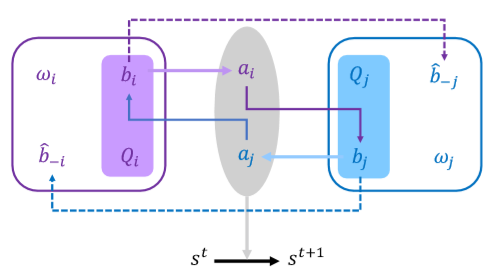 |
pdf |
abstract |
bibtex |
arXiv |
code
Currently, in the study of multiagent systems, the intentions of agents are usually ignored. Nonetheless, as pointed out by Theory of Mind (ToM), people regularly reason about other’s mental states, including beliefs, goals, and intentions, to obtain performance advantage in competition, cooperation or coalition. However, due to its intrinsic recursion and intractable modeling of distribution over belief, integrating ToM in multiagent planning and decision making is still a challenge. In this paper, we incorporate ToM in multiagent partially observable Markov decision process (POMDP) and propose an adaptive training algorithm to develop effective collaboration between agents with ToM. We evaluate our algorithms with two games, where our algorithm surpasses all previous decentralized execution algorithms without modeling ToM.
@article{yuan2019emergencecollaboration,
author = {Yuan, Luyao and Fu, Zipeng and Zhou, Linqi and Yang, Kexin and Zhu, Song-Chun},
journal= {Emergent Communication Workshop at NeurIPS},
year = {2019}
}
|
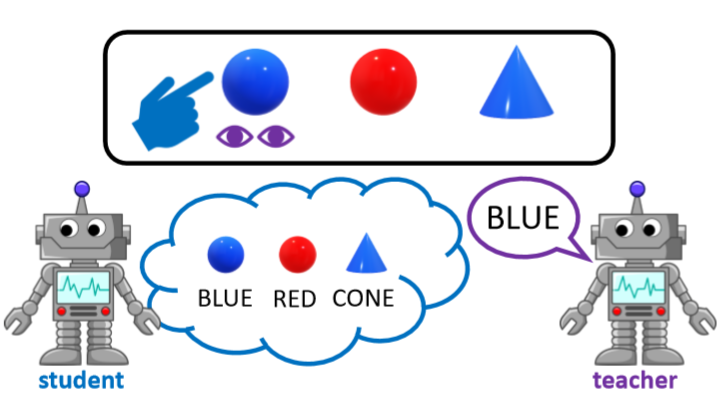 |
pdf |
abstract |
bibtex |
arXiv |
code
Pragmatics studies how context can contribute to language meanings. In human communication, language is never interpreted out of context, and sentences can usually convey more information than their literal meanings. However, this mechanism is missing in most multi-agent systems, restricting the communication efficiency and the capability of human-agent interaction. In this paper, we propose an algorithm, using which agents can spontaneously learn the ability to “read between lines” without any explicit hand-designed rules. We integrate theory of mind (ToM) in a cooperative multi-agent pedagogical situation and propose an adaptive reinforcement learning (RL) algorithm to develop a communication protocol. ToM is a profound cognitive science concept, claiming that people regularly reason about other’s mental states, including beliefs, goals, and intentions, to obtain performance advantage in competition, cooperation or coalition. With this ability, agents consider language as not only messages but also rational acts reflecting others hidden states. Our experiments demonstrate the advantage of pragmatic protocols over non-pragmatic protocols. We also show the teaching complexity following the pragmatic protocol empirically approximates to recursive teaching dimension (RTD).
@article{yuan2019emergencepragmatics,
author = {Yuan, Luyao and Fu, Zipeng and Shen, Jingyue and Xu, Lu and Shen, Junhong and Zhu, Song-Chun},
journal= {Emergent Communication Workshop at NeurIPS},
year = {2019}
}
|
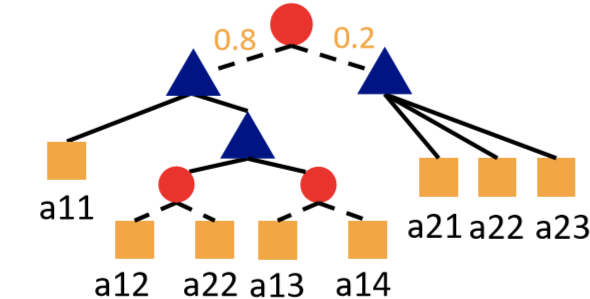 |
pdf |
abstract |
bibtex |
code (And-Or-Graph Learning Library)
Stochastic And-Or grammars form a compact representation of probabilistic contextfree grammars. They explicitly model compositionality and reconfigurability in a hierarchical manner and can be utilized to understand the underlying structures of different kinds of data (e.g., language, image, or video). In this paper, we proposed an unsupervised AndOr grammar learning approach that iteratively searches for better grammar structure and parameters to optimize the grammar compactness and data likelihood. To handle the complexity of grammar learning, we developed an algorithm based on the Monte Carlo Tree Search to effectively explore the search space. Also, our method enables incremental grammar learning. Experimental results show that our approach significantly outperforms previous greedy-search-based approaches, and our incremental learning results are comparable to previous batch learning results.
@article{yuan2019stochastic,
author = {Yuan, Luyao and Shen, Jingyue and Fu, Zipeng and Zhu, Song-Chun},
journal= {Preprint},
year = {2019}
}
|
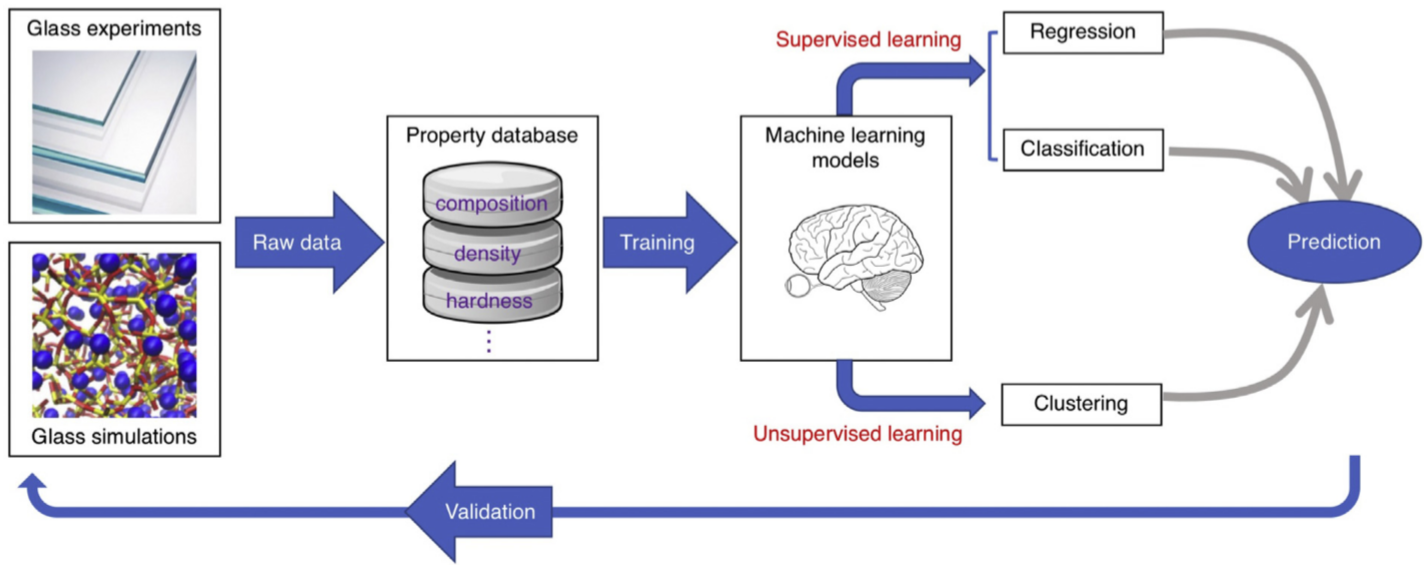 |
pdf |
abstract |
bibtex
The design of new glasses is often plagued by poorly efficient Edisonian “trial-and-error” discovery approaches. As an alternative route, the Materials Genome Initiative has largely popularized new approaches relying on artificial intelligence and machine learning for accelerating the discovery and optimization of novel, advanced materials. Here, we review some recent progress in adopting machine learning to accelerate the design of new glasses with tailored properties.
@article{liu2019machine,
author = {Liu, Han and Fu, Zipeng and Yang, Kai and Xu, Xinyi and Bauchy, Mathieu},
journal= {Journal of Non-Crystalline Solids},
year = {2019}
}
|
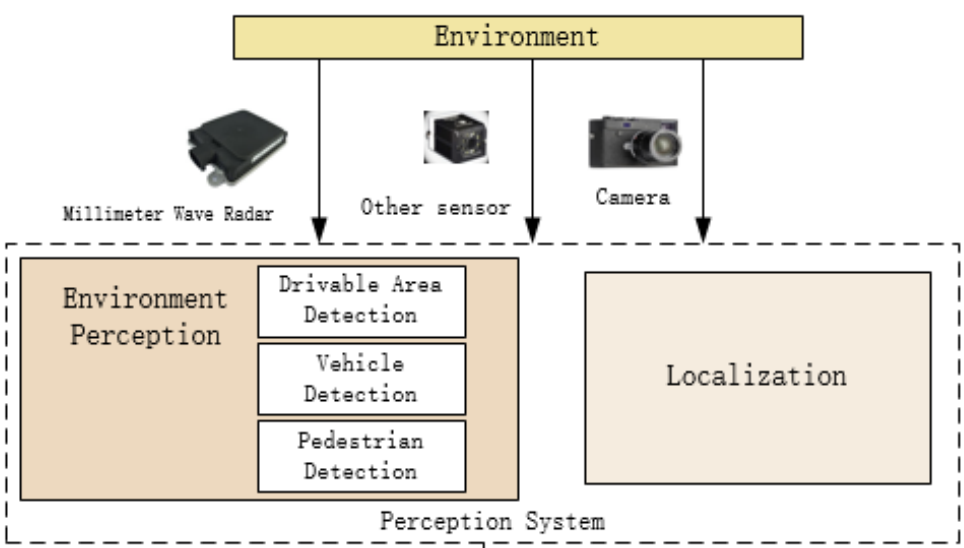 |
pdf |
abstract |
bibtex
Unmanned scene recognition means that unmanned vehicles can collect environmental data from equipped sensors and make decisions through algorithms, in which deep learning has become one of key technologies. Especially, with the discovery of adversarial examples against deep learning, the research on offensive and defensive against adversarial examples illustrates that the deep learning model for unmanned scene recognition also has the safety vulnerability. However, as far as we know, few studies have tried to explore the adversarial example attack in this field. Therefore, we try to address this problem by generating adversarial examples againist scene recognition classification model through experiments. In addition, we also try to improve the adversarial model robustness by the adversarial training. Extensive experiments have been conducted, and experimental results show that adversarial examples have an efficient attack effect on the neural network for scene recognition.
@article{wang2019adversarial,
author = {Wang, Xuankai and Li, Jinguo and Fu, Zipeng and Lu, Rongxing},
journal= {ACM TURC},
year = {2019}
}
|
 |
pdf |
abstract |
bibtex
As a prominent early instance of the Internet of Things in the smart grid, the advanced metering infrastructure (AMI) provides real-time information from smart meters to both grid operators and customers, exploiting the full potential of demand response. However, the newly collected information without security protection can be maliciously altered and result in huge loss. In this paper, we propose an energy theft detection scheme with energy privacy preservation in the smart grid. Especially, we use combined convolutional neural networks (CNNs) to detect abnormal behavior of the metering data from a long-period pattern observation. In addition, we employ Paillier algorithm to protect the energy privacy. In other words, the users’ energy data are securely protected in the transmission and the data disclosure is minimized. Our security analysis demonstrates that in our scheme data privacy and authentication are both achieved. Experimental results illustrate that our modified CNN model can effectively detect abnormal behaviors at an accuracy up to 92.67%.
@article{yao2019energy,
author = {Yao, Donghuan and Liang, Xiaohui and Fu, Zipeng and Zhang, Kai and Yang, Baojia},
journal= {IEEE Internet of Things Journal},
year = {2019}
}
|